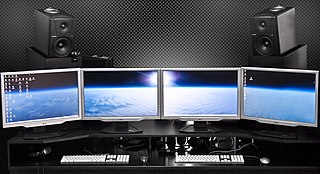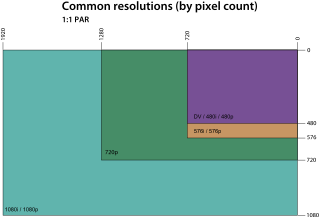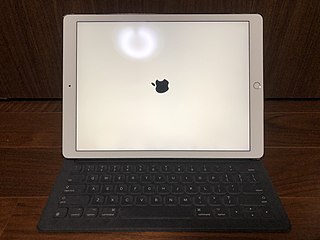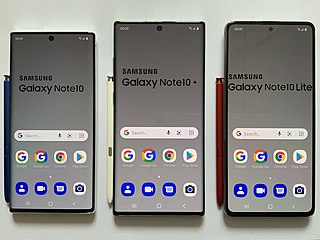
A laptop computer or notebook computer, also known as a laptop or notebook for short, is a small, portable personal computer (PC). Laptops typically have a clamshell form factor with a flat panel screen on the inside of the upper lid and an alphanumeric keyboard and pointing device on the inside of the lower lid, although 2-in-1 PCs with a detachable keyboard are often marketed as laptops or as having a "laptop mode". Most of the computer's internal hardware is fitted inside the lower lid enclosure under the keyboard, although many laptops have a built-in webcam at the top of the screen and some modern ones even feature a touch-screen display. In most cases, unlike tablet computers which run on mobile operating systems, laptops tend to run on desktop operating systems which have been traditionally associated with desktop computers.

The Apple Cinema Display is a line of flat-panel computer monitors developed and sold by Apple Inc. between 1999 and 2011. It was initially sold alongside the older line of Studio Displays, but eventually replaced them. Apple offered 20, 22, 23, 24, 27, and 30-inch sizes, with the last model being a 27-inch size with LED backlighting.

Multi-monitor, also called multi-display and multi-head, is the use of multiple physical display devices, such as monitors, televisions, and projectors, in order to increase the area available for computer programs running on a single computer system. Research studies show that, depending on the type of work, multi-head may increase the productivity by 50–70%.

IdeaPad is a line of consumer-oriented laptop computers designed, developed and marketed by Lenovo. The IdeaPad mainly competes against computers such as Acer's Aspire, Dell's Inspiron and XPS, HP's Pavilion, Envy and Stream, Samsung's Sens and Toshiba's Satellite.

DisplayLink is a semiconductor and software technology company owned by Synaptics that develops the DisplayLink USB graphics technology. This technology enables computers and displays to connect using USB, Ethernet, and WiFi, and also allows for multiple displays to be connected to a single computer. DisplayLink's primary customers include notebook OEMs, LCD monitor manufacturers, and PC accessory vendors, and their technology is compatible with a wide range of operating systems, including Microsoft Windows, macOS, Android, ChromeOS, and Linux.

The Samsung Impression is a slider-style mobile phone manufactured by Samsung Electronics. First announced on March 30, 2009, it was released on April 7, 2009. It was the first phone manufactured for the United States to have an AMOLED touch-screen.

The graphics display resolution is the width and height dimension of an electronic visual display device, measured in pixels. This information is used for electronic devices such as a computer monitor. Certain combinations of width and height are standardized and typically given a name and an initialism which is descriptive of its dimensions. A graphics display resolution can be used in tandem with the size of the graphics display to calculate pixel density. An increase in the pixel density often correlates with a decrease in the size of individual pixels on a display.

Acer Aspire is a series of personal computers by Acer Inc. aimed at casual household users or for small business use. The Aspire series covers both desktop computers and laptops.

A Chromebook is a laptop or tablet running the Linux-based ChromeOS as its operating system. Initially designed to rely heavily on web applications for tasks using the Google Chrome browser, Chromebooks have since expanded to be able to run Android and full-fledged Linux apps since 2017 and 2018, respectively. All supported apps can be installed and launched alongside each other.

A 2-in-1 PC, also known as convertible laptop, 2-in-1 tablet, 2-in-1 laptop, 2-in-1 detachable, laplet, tabtop, laptop tablet, or simply 2-in-1, is a portable computer that has features of both tablets and laptops.

Lenovo Yoga is a line of consumer-oriented laptop computers and tablets designed, developed and marketed by Lenovo, named for their ability to assume multiple form factors due to a hinged screen.
The HP Envy is a line of consumer-oriented high-end laptops, desktop computers and printers manufactured and sold by HP Inc. They started as a high-end version of the HP Pavilion line.

The Nexus 10 is a tablet computer co-developed by Google and Samsung Electronics that runs the Android operating system. It is the second tablet in the Google Nexus series, a family of Android consumer devices marketed by Google and built by an OEM partner. Following the success of the 7-inch Nexus 7, the first Google Nexus tablet, the Nexus 10 was released with a 10.1-inch, 2560×1600 pixel display, which was the world's highest resolution tablet display at the time of its release. The Nexus 10 was announced on October 29, 2012, and became available on November 13, 2012.
The ThinkPad Twist is a 2-in-1 convertible tablet, that can function as a laptop and tablet released in 2012. The Twist is designed for business users and runs Microsoft's Windows 8 operating system.
The Lenovo IdeaPad Yoga 11 is a hybrid laptop/tablet Windows RT-based computer released in late 2012. The Yoga 11 gets its name from its ability to change form factors thanks to the two-way hinge used to mount its display. It was discontinued on July 17, 2013, due to the poor sales of Windows RT devices.

The LenovoIdeaPad Flex is a 2-in-1-laptop line by Lenovo. Unlike the Lenovo IdeaPad Yoga line of devices, the keyboard does not bend back entirely to allow use as a tablet, it is only a dual-mode laptop. Its keyboard rotates behind the display in order to put the device into "stand mode." Stand mode brings the user closer to the screen for watching videos and using touch-enabled apps and removes the visual distraction from the keyboard.

Samsung DeX is a feature included on some high-end Samsung handheld devices that enables users to extend their device into a desktop-like experience by connecting a keyboard, mouse, and monitor. The name "DeX" is a contraction of "Desktop eXperience".

The second generation of iPad Pro is a line of iPad tablet computers designed, developed and marketed by Apple Inc. The iPads, with 12.9 inch and 10.5 inch screens, were both announced on June 5, 2017. Both models are compatible with the first generation of Apple Pencil. Like the first generation, a larger size and stylus compatibility were a point of difference from the rest of Apple's available iPads.

The Samsung Galaxy Note 10 is a line of Android-based phablets designed, developed, produced, and marketed by Samsung Electronics as part of the Samsung Galaxy Note series. They were unveiled on 7 August 2019, as the successors to the Samsung Galaxy Note 9. Details about the phablets were widely leaked in the months leading up to the phablets' announcement.

The Samsung Galaxy Note 20 and Galaxy Note 20 Ultra are a series of high-end Android-based phablets designed, developed, produced, and marketed by Samsung Electronics as part of their Samsung Galaxy Note series, succeeding the Samsung Galaxy Note 10 series. The phablets were announced on 5 August 2020 alongside the Samsung Galaxy Z Fold 2, Galaxy Watch 3, Galaxy Buds Live and Samsung Galaxy Tab S7 during Samsung's Unpacked Event. It was the final model in the Galaxy Note series, with Samsung beginning to integrate the functionality from the Note series into its S series "Ultra" models, starting with the Galaxy S22 Ultra.
















